
In the early 1830s New Jersey, there was a picturesque and grandiose town established, situated in Monmouth County. Located thirteen miles south of Freehold, and six miles west of Sea Girt, the settlement was known as the town of Allaire. For two decades the town ranked as one of the largest industrial centers in the Eastern United States. The construction of an iron smelting works marked the town’s beginning.
Incorporated in 1828, the Howell Works Company began operations and a company town was created. Only three years thereafter, in 1831 the company was sold, and James P. Allaire, the company’s president, purchased the company as its sole owner.
After acquiring the company, Allaire began systematic initiatives to make improvements to his company, as well as the company town that supported it. A modern smelting furnace was erected, which replaced the less efficient and outdated one. Infrastructure connecting the town was upgraded, and roads leading to the town were improved. Docks at Oceanport were built, sloops were procured, and regular shipping routes to New York City commenced.
Company housing was built for employees, as well as all of the other enterprises and buildings necessary for a functional town.
Allaire built a waterworks, a mill, a bakery, a company general store, a church for worship, a carpenter’s shop, and a factory for manufacturing screws. Other ancillary buildings were also constructed, including housing for company foremen, an enameling house, as well as a charcoal fuel depot.
Along with the company’s core industrial activities, about 500 total men were in employed in the various industries which comprised the town.
Five large farms, abutting the town, were bought to supply fresh food, as well as provide the necessary land to construct a canal to bring water to the town from the nearby Mingemahone Brook.
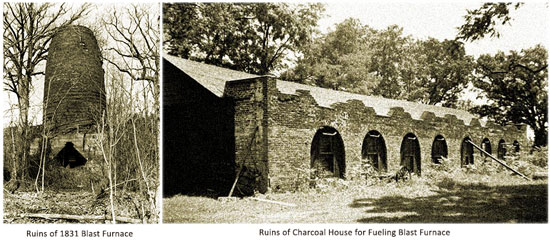
Eventually stage coach lines were brought into service. Daily, scheduled trips to and from other New Jersey towns were offered. Steamboat lines soon replaced Allaire’s older sloops, and goods were brought in from New York to further supply the town. The same steamers, in their outbound voyages back to New York, were utilized to ship Allaire’s finished iron products to the city.
Unfortunately the prosperity at Allaire was not to last. The financial panic of 1837 crippled James Allaire and his access to capital. Allaire, who had extensive works in New York city, had to divest his ownership in them to weather the financial storm.
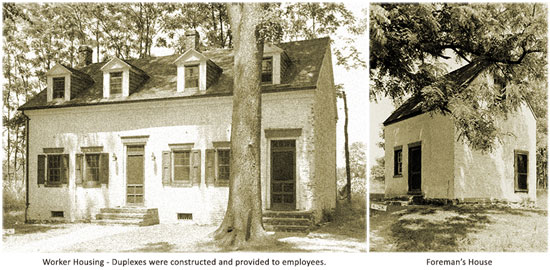
But alas such initiatives were not enough. Soon thereafter, new methods for smelting were discovered.
New and improved methods of combustion were innovated, and suddenly his relatively new furnace passed into obsolescence. Quickly it became evident the Allaire’s iron could not be produced at his Howell plant as cheaply as it could be elsewhere.

In 1846 Allaire reluctantly announced that Howell’s furnace could no longer profitably make iron.
Allaire’s closing of the furnace marked the death-knell of the town.
Very soon thereafter, the town’s other industries shuttered and its population dwindled and finally disappeared.
For almost a century afterwards, the town languished in ruins. Many of the town’s buildings fell into disrepair and had either been razed or had collapsed onto themselves. It wasn’t until sometime after the beginning of the 20th century that the town was noticed again by curious passer-bys.
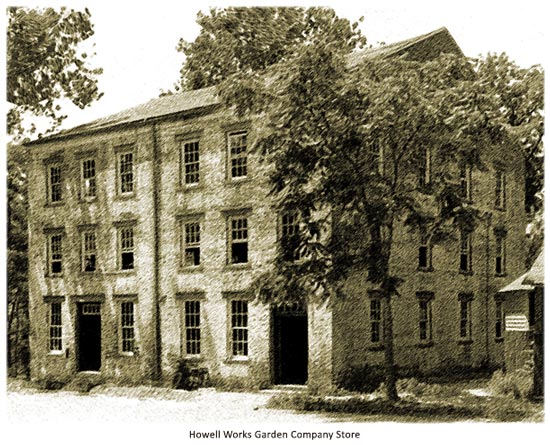
All that said, during the company prosperous but yet short heydey, in 1834 supplies of privately minted bronze and copper coins were struck for the town. As was common during the era, circulation of regular U.S. Coinage was quite scarce. To alleviate the shortage and promote commerce among the town’s residents, Allaire had tokens of one and two cents struck, along with private currency that ranged from six-cents to $15. Unlike other shinplasters of the era, Allaire’s name and company on the emissions were considered sufficient guarantees that his private money was financially sound.
Numismatic Specimens
Below please find several Howell Works specimens.
The first specimen was struck as a one-cent piece in copper, and possesses an R-4 rarity rating on the Hard Times Rarity Scale. Rulau dates it to 1834 and catalogues it as HT-200.
The second specimen was struck as a 2-cent piece. Possessing a rarity rating of R-3, it is slightly less rarer than the first. Also struck in copper, Rulau lists the specimen as HT-201 and dates it to 1835.
The third specimen was also struck as a 2-cent piece, and also possesses a rarity rating of R-3. Like the specimen above, it was struck on a copper planchet. However uniquely in this specimen’s case, it appears to have been minted atop a previously struck token.
The fourth specimen was also a 2-cent piece. This particular specimen has a clipped planchet.
In addition to metallic tokens, Howell Works Company also printed and issued paper scrip. The specimen below is a 50-cent note. Rulau lists it as HT-Q69, but does not assign any rarity rating to it. The note was printed contemporaneously as the above tokens.
The specimen below was engraved and printed by Engravers Rawdon, Wright, Hatch & Co. of New-York. The features a beautiful and custom vignette of the Howell Works — the image most commonly associated with the company. The right panel features a vignette of Benjamin Franklin. The note, catalogue number Wait-833, possesses an Extra-Fine grade, and was also printed during the 1830s.
The final specimen below is listed as Rulau HT-Q71. Likewise printed and issued contemporaneously, it shares many of the same devices as the 1-dollar note but in opposite locations. It was also engraved and printed by Rawdon, Wright, Hatch & Co. of New York as well.
Historical Status
Ultimately the remaining buildings and property of the town were granted historic status. They were preserved and restored, and made available for access and study by the general public.

Aaron Packard ![]()
Notes and Sources
-
Library of Congress Digital Archives
-
Standard Catalog of United States Tokens 1700-1900 Fourth Edition, Russell Rulau, Krause Publications, ©2004
-
A Guide Book of United States Tokens and Medals, Katherine Jaeger, Whitman, ©2008
- New York’s Crystal Palace & The H.B. West Tokens - November 6, 2019
- Edward Aschermann’s Cigar & Tobacco Tokens - November 2, 2019
- George T. Hussey & His Special Message Tokens - October 30, 2019








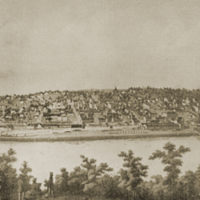
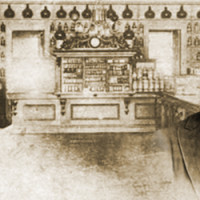
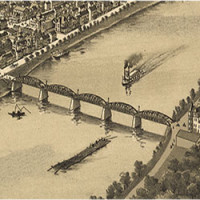
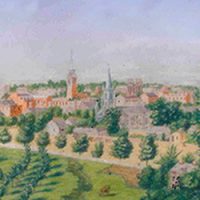

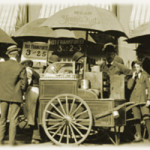
Very interesting article. I have one of the specimens above being graded currently and have approached Allaire Historic Village about possible displaying the coin along with this article. I have to meet the gentleman in charge on his day on, sometime this summer.
We’d be happy to display the coinage and money from the Howell Iron Works Co. at Allaire. We can help get the dates and some info above updated – on the history that is. We know some things about the money and coins but not all. Would love to know more. Summer is best to discuss as it slows a little bit for me.
PS – visit the re-opened Enameling Building at Allaire for history post-1846 and the role played by Arthur Brisbane for donating over 1,200 acres and the village to the people of the State of NJ – free of charge! A spectacular history and person.
Chairman of the Board – Allaire Village Inc.
I will work on getting down there as soon as I can. I have picked up a few more coins since this last article was published.
thank you.
my contact info is casale5@hotmail.com
Joe
I am looking for genealogies of the Johnson families that lived and worked at Howell works.
I reviewed my research on Howell Works, and unfortunately I was unable to find any references to the Johnson families at Howell Works.
Just stumbled upon this article again. Completely forgot about the coins for display. How are you handling the COVID 19 restrictions?
Hi Joseph –
We are staying safe. Hope you and yours are likewise.
Thanks,
Aaron Packard